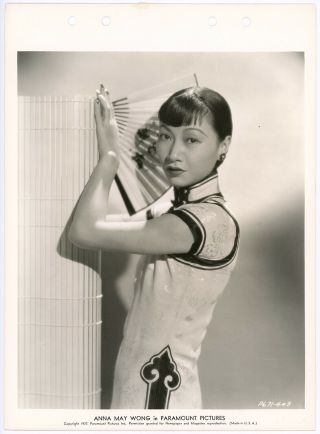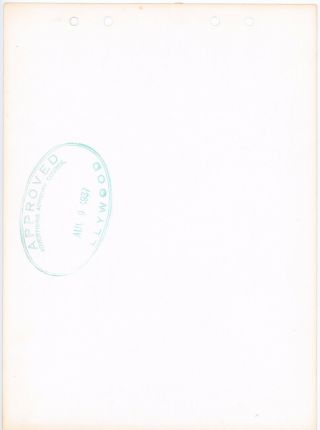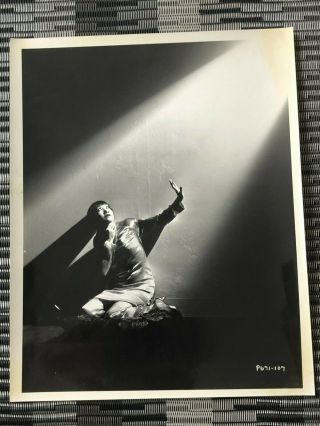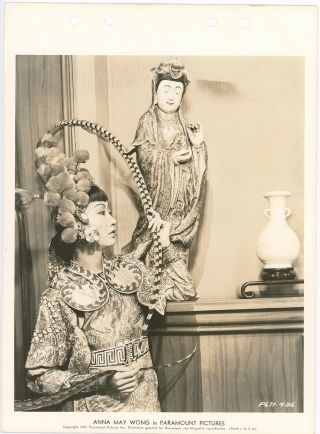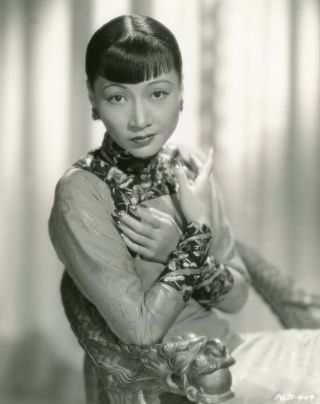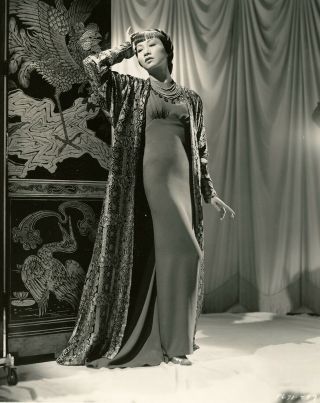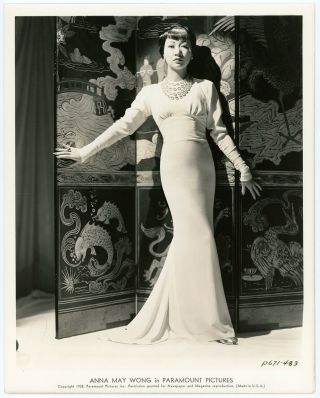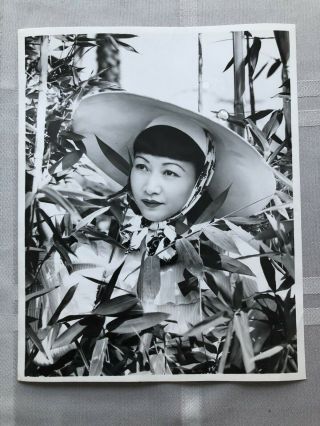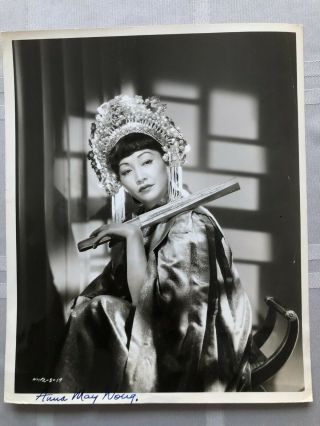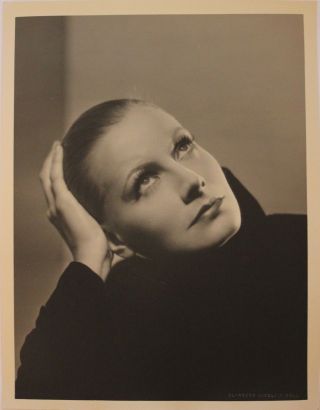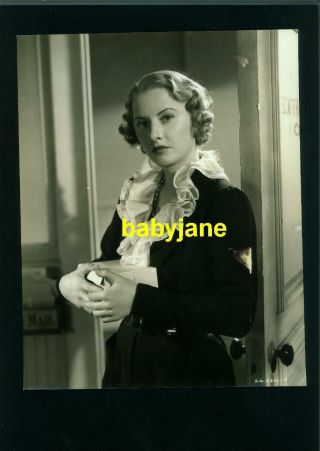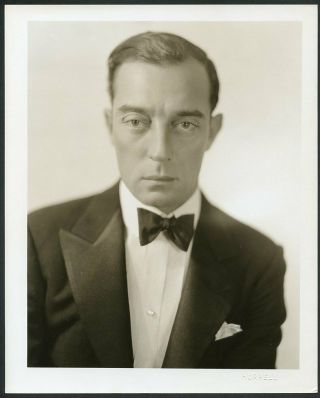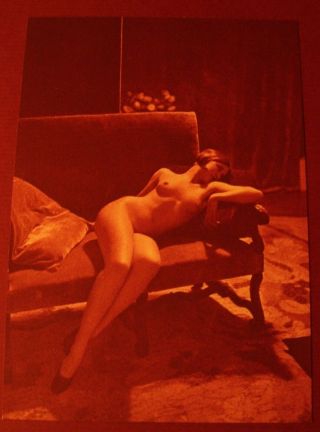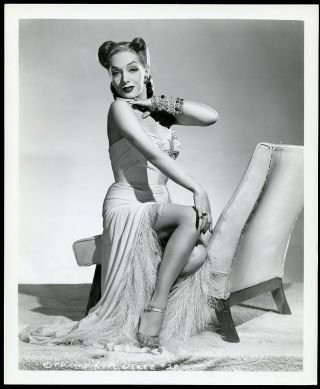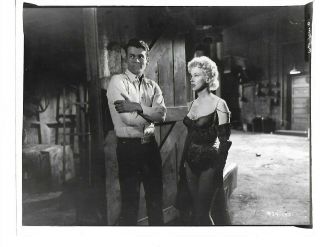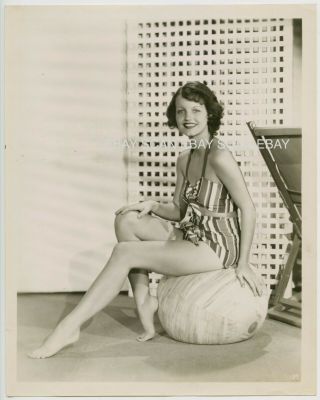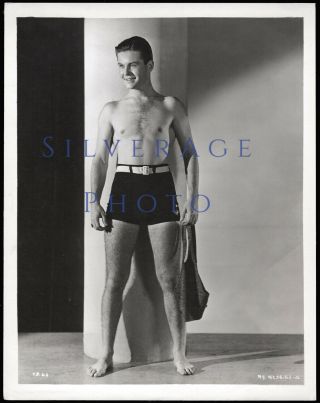Pioneering Chinese American Movie Star Anna May Wong Photograph 1937
Item History & Price
Considered to be the first Chinese American Hollywood movie star, as well as the first Chinese American actress to gain international recognition, Wong's varied c...areer spanned silent film, sound film, television, stage, and radio.
Photograph measures 8" x 11" on a glossy, double weight paper stock with A.A.C. ink stamp on verso.
Guaranteed to be 100% vintage and original from Grapefruit Moon Gallery.
More about Anna May Wong:
The first Chinese-American movie star, Anna May Wong spent her life struggling against prevailing attitudes and discrimination and, in the end, proved too far ahead of her time to enjoy the career and life she deserved. Alternately considered "too Chinese" or "too American" by various audiences, Los Angeles native Wong achieved movie stardom in the first Technicolor film, "The Toll of the Sea" (1922). Frequently cast stereotypically as either a delicate victim or a menacing "dragon lady, " Wong scored again in "The Thief of Bagdad" (1924) but struggled to find leading roles since law prohibited her kissing a co-star of a different race. After a stint in Europe, where she received the acclaim long denied her in America with such films as "Piccadilly" (1929), she returned home to appear in "Daughter of the Dragon" (1931) and "Shanghai Express" (1932). She suffered a major public blow when she was passed over for "The Good Earth" (1937) in favor of a Caucasian actress Luise Rainer in Asian-inspired makeup, and encountered animosity from white as well as Chinese audiences. She did go on to topline her own TV show, "The Gallery of Madame Liu-Tsong" (DuMont, 1951), before dying of a heart attack on Feb. 3, 1961. Immortalized with a star on the Hollywood Walk of Fame and in a sculpture as one of four pioneering "Ladies of Hollywood, " Anna May Wong never reached the heights her talent, charisma and beauty deserved, but remained a bit of a Golden Age cult icon whose glowing legacy grew stronger with each passing year.
Born Jan. 3, 1905 in Los Angeles, Wong Liu Tsong was the daughter of second-generation Chinese-American parents. She would later take on the Anglicized name "Anna May Wong." Although she spoke flawless English and was truly an "American" in every sense of the world, she grew up in a nation and world whose laws and attitudes were extremely prejudicial against Chinese people at that time. Wong had the unique destiny of growing up not feeling that she belonged to any world: her tall height, large eyes and fierce independence caused many Chinese people to think she was "too American" while her appearance and lineage kept her "too Chinese" for many Americans. Like many dreamers and forward-thinkers who are ahead of their time, Wong was drawn to the world of the cinema. Not only would she spend as much time as she could in movie theaters seeing the finished product, she would also hang around film shoots in her native Chinatown, asking filmmakers so many questions about the process that they dubbed her "C.C.C." or "Curious Chinese Child." Frequently skipping school to feed her passion for film and disobeying her strict, traditional father, Wong broke into the business as an extra in such films as "The Red Lantern" (1919), "Dinty" (1920) and "Outside the Law" (1920). Such was the world in which Wong lived that she was forced by her father to be locked into a room alone during lulls in filming if she were the only Asian in the cast, and had to drop out of school altogether in 1921.
Her first major role came with the lead in "The Toll of the Sea" (1922), where she played Lotus Flower, a young villager who rescues a white sailor from the ocean. Although cultural conventions make it impossible for them to marry, Lotus Flower becomes pregnant and after the sailor leaves, stays true to his memory while awaiting his return. Tragically, he does return with a white wife, and the girl surrenders her child to him before committing suicide. The first film shot in Technicolor, the movie was gloriously alive, showcasing the gorgeous Wong as an actress of immense power and charisma and earning her glowing reviews across the board. For a white actress, the film would have been a steppingstone to superstardom, but Wong’s path proved much more difficult. Recognizing her talent, Douglas Fairbanks cast her in a small but important role as a Mongo slave in the blockbuster adventure "The Thief of Bagdad" (1924). The role would prove prophetic in that, while she performed it with enormous aplomb, Wong found the most acceptance from American audiences as an Asian "Dragon Lady" stereotype, one that was considered shameful by Chinese audiences, including her own family. In fact, Wong would become estranged from most of her family who looked down on her work, although she was still financially supporting them. She went on to play the Native American princess Tiger Lily in "Peter Pan" (1924) and an Eskimo in "The Alaskan" (1924) as well as starting a modeling career.
Like other actresses of color who had leading lady potential, Wong faced an insurmountable obstacle that limited her roles: she was forbidden by law to kiss a male co-star of a different race, drastically reducing the leading lady roles she could consider playing in American pictures. Insultingly, she was also frequently passed over for roles as Chinese women since she did not fit the stereotypical "Chinese" look American audiences expected, and was frequently forced into bit parts, while white actresses scored leads in Asian-inspired makeup, as happened with the egregious miscasting of Myrna Loy "The Crimson City" (1928), while Wong was relegated to a tiny role. Although she attempted to start her own production company to help remedy this unfairness, it never got off the ground, although she did drive the first rivet at the groundbreaking ceremony for Grauman’s Chinese Theatre. Frustrated with the paucity of parts available to her in America, Wong moved to Europe, where she quickly achieved the fame and public adoration denied to her in the States. Many critics of the time and later film historians would point to her work in "Piccadilly" (1929) as her finest, where she played an alluring maid who catches the eye of a London nightclub impresario and becomes a successful dancer, proving once and for all that she was among the most hypnotic and charismatic screen stars of her generation. In England, she starred in the play "A Circle of Chalk" opposite Laurence Olivier and become a film and theatrical star in France and Germany as well. Named "the best dressed woman in the world" as well as "the world’s most beautiful Chinese girl, " Wong was fawned over by multiple news and gossip outlets, but also encountered considerable hostility from, of all places, China, who decried the roles she played as culturally damaging.
After returning to the United States with her profile boosted, Wong was promised better roles by studio execs, but this turned out to be a hollow offer. Although she delivered a first-rate, memorable performance as the ruthless "Daughter of the Dragon" (1931), Wong was essentially cast as another "Dragon Lady." She stole scenes from Marlene Dietrich in the Oscar-winning "Shanghai Express" (1932) but was dogged by rumors of a lesbian relationship with the German superstar. Wong’s heart was truly broken, however, when she was denied the opportunity to play her dream role: the long-suffering, heroic O-Lan, wife of the farmer Wang Lung (Paul Muni) in the heavily anticipated 1937 film adaptation of Pearl S. Buck’s Nobel-Prize-winning classic The Good Earth. Later generations could never fathom why Wong would be denied such a plum role over Caucasian actress Luise Rainier, but again, she was shut out due to the impossibility of a Chinese actress and white actor playing onscreen spouses as well as the tragic fact that the Chinese government actively campaigned against her inclusion. Although she was offered the supporting role of Lotus, a hard-edged concubine, Wong refused the role on the grounds that, as a Chinese-American actress in a cast mostly made up of Americans playing Chinese characters, that it was unthinkable for her to play the lone unsympathetic role. The film’s success – including Rainer’s Best Actress Oscar for playing O-Lan – an achievement considered by some to be one of the worst affronts in Hollywood history.
"The Good Earth" fiasco wounded Wong so deeply, she once again left America, embarking on a tour of China where she received a mixed reception. Although she continued to work in B-level fare, including roles in the propaganda films "Bombs Over Burma" (1942) and "Lady from Chungking" (1942), Wong also made history with the starring role on the groundbreaking series "The Gallery of Madame Liu-Tsong" (DuMont, 1951), which featured her as a detective and was the first TV series starring an Asian-American. Stinging from the unrelenting negativity she faced from all sides for any venture she attempted, Wong largely retired from acting, although she did attempt a comeback with a small role as Lana Turner’s maid in "Portrait in Black" (1960) as well as landing the role of Madame Liang in the film adaptation of "Flower Drum Song" (1961), a role she was unfortunately never to play, because she died of a heart attack on Feb. 3, 1961. Although a more obscure figure for modern audiences than she deserved, Wong did earn a star on the Hollywood Walk of Fame and was also depicted as one of the four pioneering "Ladies of Hollywood" in a landmark sculpture that also included Dorothy Dandridge, Dolores del Rio and Mae West. The first Chinese-American movie star as well as the first Asian-American who became an international star, Anna May Wong never received her fair due as a cinematic and pop cultural icon, but, decades later, critics and fans alike began to reclaim her hugely deserved legacy as a gifted actress whose jaw-dropping resilience in the face of an unsympathetic and racist world and industry, was matched only by her enormous artistic talent.




